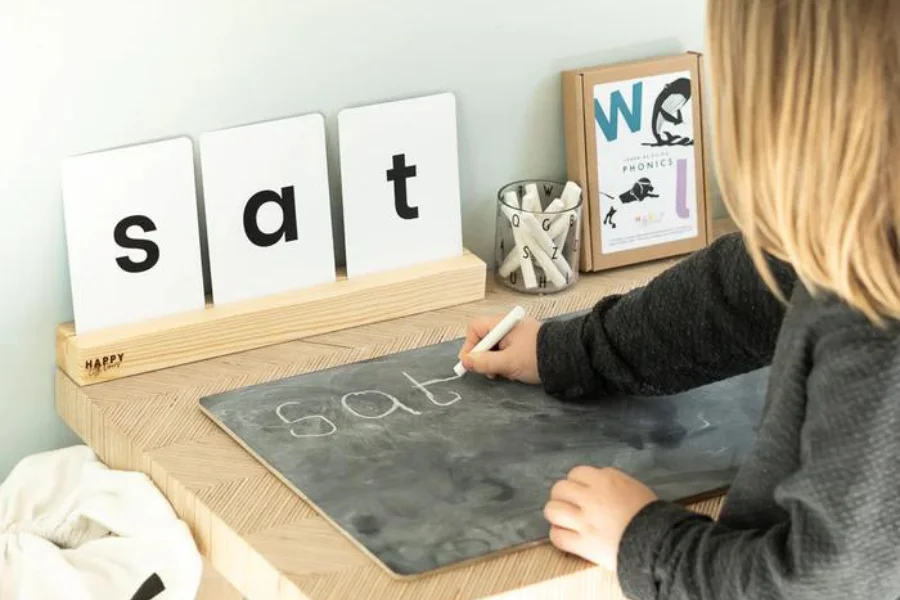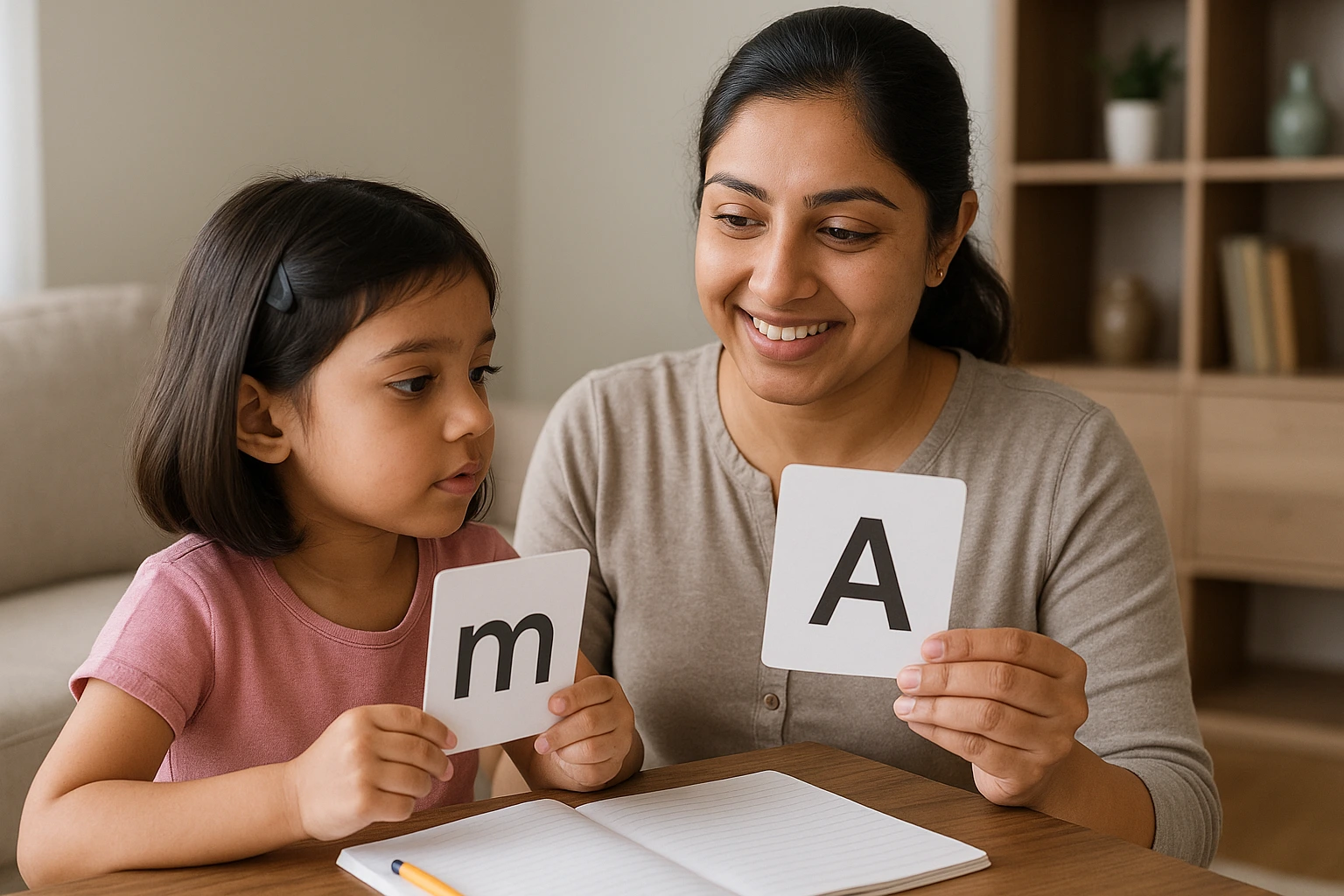How to Teach Letter Sounds Phonics?
How to Teach Letter Sounds Phonics?
Helping children to read begins with guiding them in understanding the association between articulated sounds and written letters. Known as Letter Sounds Phonics, this approach establishes a strong academic foundation, helping children identify individual sounds like /p/ for P or /u/ for U, which later helps in blending words while reading.
Familiarity with Letter Sounds Phonics prepares children for prospective reading success by making reading more effortless and enjoyable.
Table of Content
Should you Teach Letter Sounds or Letter Names First?
The query of whether you should Teach Letter Sounds or Letter Names First often arises when introducing early literacy. Many educators and specialists suggest teaching Letter Sounds before letter names. This approach supports reading readiness more effectively.
Teaching Letter Sounds Phonics first has several benefits:
- Direct link to reading: Children use letter sounds to interpret words. Recognizing the sound /s/ in “sun” helps them read it, whereas knowing the name “see” does not directly help reading.
- Creates phonemic understanding: Understanding Sounds helps children hear and use sounds, a critical early reading skill.
- Supports spelling and writing: Children can begin to spell words once they know the sounds, based on how they hear them.
Initially, letter names can be confusing. For instance, the letter “c” is named “see,” but its typical sound is /k/. This mismatch may cause difficulties in interpreting skills.
Letter names can be gradually introduced once a stable foundation in Letter Sounds is established. Beginning with Letter Sounds Phonics gives children the tools they need to link articulated and written language, making early literacy instruction more effective and significant.
For downloading the brochure of Phonics Training Course, Click Here!
Call or Whatsapp on +918104606573 / +919869866277, for details of Phonics Training Course!

Source: oakandever
What is the Right Order to Teach Letter Sounds?
An excellent way to help children build adept reading and writing skills is to Teach Letter Sounds Phonics in the correct order. With a systematic order, children recognize sounds more effortlessly and blend them into words quickly. The right approach to teaching Letter Sounds boosts early literacy development while keeping learning vibrant and engaging.
Let us have a look at the Right Order to Teach Letter Sounds to Children:
Start with Common Sounds
Start with simple and commonly used Consonant and Vowel Letters such as s, a, t, p, i, n. These sounds can be blended easily to form basic words like sat, pin, tap, etc.
Move to Other Consonants
After children are confident with the initial sounds, familiarize them with the remaining sounds. These strengthen the Phonics basis and support word-building mastery.
Familiarize Digraphs Early
Next come sounds like sh, ch, th, ng, etc. These two-letter groups convey single sounds and are typical in everyday words, making them an essential aspect of Letter Sounds Phonics.
Long Vowel Sounds and Variants
Once introductory phonics patterns are taught, familiarize long vowels and alternate spellings such as ai, ee, oa, etc. These help children master vowel modifications, thus making the reading of intricate words easier.
Introduce Tricky Words Separately
Some words do not obey standard Letter Sounds Phonics rules. Teach these high-frequency words individually to avert confusion and support proficiency.
A thoughtful order when teaching Letter Sounds builds confidence and ensures children master the essential sounds necessary for early reading success.
For downloading the brochure of Phonics Training Course, Click Here!
Call or Whatsapp on +918104606573 / +919869866277, for details of Phonics Training Course!

How Many Letter Sounds should you Teach your Child at a Time?
Phonics Sounds are one of the most established means to develop early reading skills. However, understanding How Many Letter Sounds should you Teach your Child at a Time is just as crucial as the approach used. Overstuffing children with too many sounds at one time can lead to frustration and confusion.
The following will help to decide How Many Letter Sounds to Teach at a Time:
Begin with 1–2 Letter Sounds at a Time
Start by teaching 1 to 2 letter sounds only in one session when your child has just started learning. Introducing fewer sounds initially helps a child get the flow of learning.
Repeat and Reinforce
Before advancing to further sounds, ensure previously taught sounds are clear with your child. Use revision through creative exercises, pictures, and descriptions to help the child retain the knowledge.
Follow a Fix Cycle
A fix cycle functions well for many children. Spend a week strengthening the current set of Letter Sounds Phonics before rolling on to the next group. This cycle supports long-term memory and sound blending proficiency.
Watch for Readiness Signs
Every child requires a different amount of time to understand something. If your child retains the sounds quickly and integrates them independently into simple words, they’re ready for further learning. Slow down and spend extra time in revision if you see your child struggling.
Perseverance and patience are the keys to teaching letters and sounds, as they help build an impressive basis for reading. Familiarizing children with too many sounds at once can overpower them, while the right pace facilitates continuous advancement.
For downloading the brochure of Phonics Training Course, Click Here!
Call or Whatsapp on +918104606573 / +919869866277, for details of Phonics Training Course!
How to Teach Letter Sounds to Children?
Teaching Phonics demands a systematic approach. Understanding the letter-sound connection helps children in acknowledging how words are constructed, making reading and spelling much more effortless.
Teach Letter Sounds to Children by embracing the following methodical approach:
Start with Simple Sounds
Teach single consonant sounds initially. Letters like d, o, and t are easier to enunciate and recall. Avoid teaching letters with identical sounds together to avert chaos.
Use Visual and Auditory Cues
Children retain best with visuals and sounds. Visual cards, letter diagrams, and phonics jingles help associate the letter with its sound. Consistently listening to the correct Letter Sounds helps support recognition.
Training with Everyday Objects
Associate each letter sound with objects children see often. For instance, f for fan, p for pot, etc. This makes Letter Sounds Phonics relatable and more effortless to remember.
Familiarize Short Vowel Sounds Early
We come across short vowel sounds in many simple words. Teaching them at the beginning creates a rich foundation in Letter Sounds.
Revision and Assessment
Revision boosts memory. Revise previously learned sounds daily through riddles, exercises, or short reading sessions. Keeping the sessions brief and entertaining preserves interest.
Blend Sounds to Form Words
Teach children to blend sounds into words. Advance to three-letter words once children are clear with two-letter combinations.
Children develop confidence and proficiency with letters and phonics sounds when creative and methodical techniques are embraced. This method makes early reading enjoyable and more successful.
For downloading the brochure of Phonics Training Course, Click Here!
Call or Whatsapp on +918104606573 / +919869866277, for details of Phonics Training Course!

Fun Ways to Teach Letter Sounds
Familiarizing Letter Sounds Phonics can be entertaining when the right strategies are adopted. Making learning fun helps children connect better with the sounds of each letter. They learn best through play, interaction, and repetition. To gain expert knowledge in teaching phonics the right way, consider joining Vidhyanidhi Education Society’s (Govt. Regd.) Phonics Teacher Training Course, which trains educators in creative methods to Teach Letter Sounds effectively.
Some fun ways to Teach Letter Sounds include:
Sound and Picture Match
Use flashcards with pictures and letters. Let children match the beginning sound of the word to the correct letter. This strengthens their ability to associate sounds with letters.
Phonics Songs and Chants
Rhythmic songs with repetitive letter sounds help children memorize easily. For example, songs like “A says a, a, apple” work wonders for auditory learners.
Alphabet Sound Games
Play games like “I Spy with my little eye” using Letter Sounds. Say, “I spy something that begins with /f/” and let children think of the object.
Sand Tray Writing
Have kids write letters in sand while saying the sound aloud. This sensory method connects touch with Letter Sounds Phonics.
Story Time Sound Hunt
Read short stories and ask children to clap whenever they hear a specific letter sound. This improves listening skills and sound recognition.
Letter Sound Art
Create crafts or drawings for each letter. For example, make a collage of all things that begin with the letter “S” while repeating the /s/ sound.
To develop mastery in these creative techniques, enroll in Vidhyanidhi Education Society’s (Govt. Regd.) Phonics Teacher Training Course. The course not only trains you in methods to Teach Letter Sounds Phonics but also boosts your confidence as an educator. Joining the Phonics Teacher Training Course guarantees you’re ready to make learning fun and influential for young minds.
Master phonics skills—join Vidhyanidhi’s Phonics Training Course today!
For downloading the brochure of Phonics Training Course, Click Here!
Call or Whatsapp on +918104606573 / +919869866277, for details of Phonics Training Course!
FAQs
Should I Teach Uppercase or Lowercase First?
Start with lowercase letters first, as they appear repeatedly in reading and writing, making them fit for early literacy.
Should Letter Names and Sounds be Taught Together?
Focus on letter sounds first for better reading readiness; introduce names gradually alongside familiar sounds for better recall.





